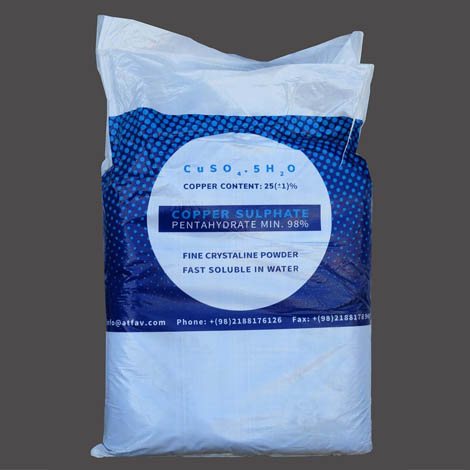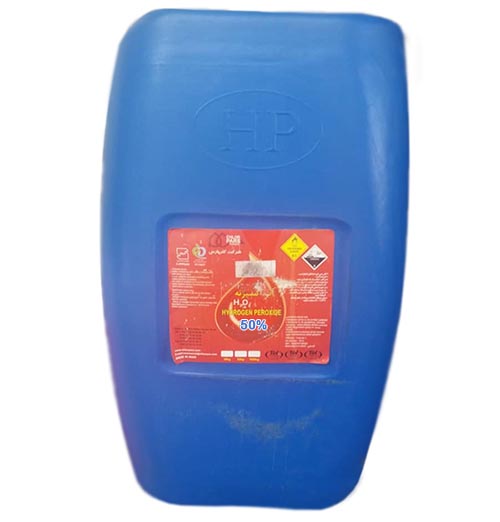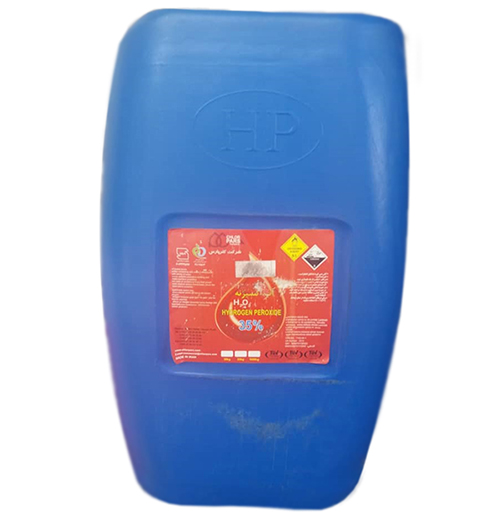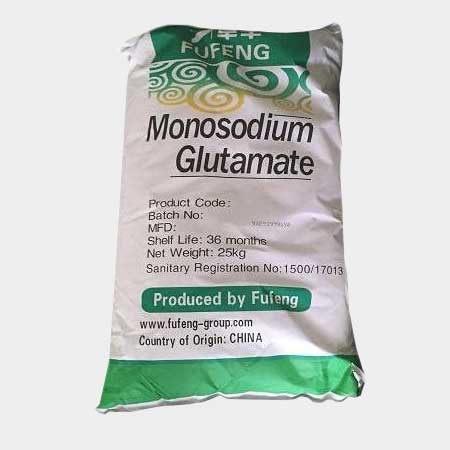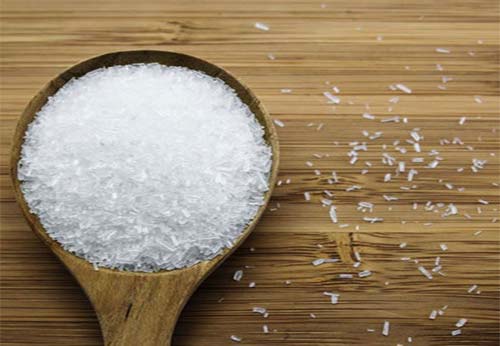Copper(II) sulfate
Copper(II) sulfate, also known as copper sulphate, are the inorganic compounds with the chemical formula CuSO4(H2O)x, where x can range from 0 to 5. The pentahydrate (x = 5) is the most common form. Older names for this compound include blue vitriol, bluestone,vitriol of copper, and Roman vitriol.
The pentahydrate (CuSO4·5H2O), the most commonly encountered salt, is bright blue. It exothermically dissolves in water to give the aquo complex [Cu(H2O)6]2+, which has octahedral molecular geometry. The structure of the solid pentahydrate reveals a polymeric structure wherein copper is again octahedral but bound to four water ligands. The Cu(II)(H2O)4 centers are interconnected by sulfate anions to form chains. Anhydrous copper sulfate is a light grey powder.
DM : Anti-fouling solution
Antifouling systems
The immersed hull and fittings of a ship at sea, particularly in coastal waters, are subject to algae, barnacle, mussel, and other shellfish growth that can impair its hydrodynamic performance and adversely affect the service of the immersed fittings.
Fittings such as cooling water intake systems are often protected by impressed current antifouling systems, and immersed hulls today are finished with very effective self-polishing antifouling paints.
Impressed current antifouling systems
The functional principle of these systems is the establishment of an artificially triggered voltage difference between copper anodes and the integrated steel plate cathodes. This causes a minor electrical current to flow from the copper anodes, so that they are dissolved to a certain degree. A control unit makes sure that the anodes add the required minimum amount of copper particles to the sea water, thus ensuring the formation of copper oxide that creates ambient conditions precluding local fouling. A control unit can be connected to the management system of the vessel. Using information from the management system, the impressed current antifouling system can determine the amount of copper that needs to be dissolved to give optimum performance with minimum wastage of the anodes.
Ferric Chloride
Iron(III) chloride is the inorganic compound with the formula (FeCl 3). Also called ferric chloride, it is a common compound of iron in the +3 oxidation state. The anhydrous compound is a crystalline solid with a melting point of 307.6 °C. The color depends on the viewing angle: by reflected light the crystals appear dark green, but by transmitted light they appear purple-red.
Anhydrous
Anhydrous iron(III) chloride has the BiI3 structure, with octahedral Fe(III) centres interconnected by two-coordinate chloride ligands.
Iron(III) chloride has a relatively low melting point and boils at around 315 °C. The vapour consists of the dimer Fe 2Cl 6 (cf. aluminium chloride) which increasingly dissociates into the monomeric FeCl 3 (with D3h point group molecular symmetry) at higher temperature, in competition with its reversible decomposition to give iron(II) chloride and chlorine gas.
Hydrates
In addition to the anhydrous material, ferric chloride forms four hydrates. All forms of iron(III) chloride feature two or more chlorides as ligands, and three hydrates feature FeCl4−.
- hexahydrate: FeCl3.6H2O has the structural formula trans-[Fe(H2O)4Cl2]Cl.2H2O
- FeCl3.2.5H2O has the structural formula cis-[Fe(H2O)4Cl2][FeCl4].H2O.
- dihydrate: FeCl3.2H2O has the structural formula trans-[Fe(H2O)4Cl2][FeCl4].
- FeCl3.3.5H2O has the structural formula cis-[FeCl2(H2O)4][FeCl4].3H2O.
Formaldehyde
Formaldehyde (systematic name methanal) is a naturally occurring organic compound with the formula CH2O (H−CHO). The pure compound is a pungent-smelling colourless gas that polymerises spontaneously into paraformaldehyde (see Formaldehyde#Forms), hence it is stored as an aqueous solution (formalin). It is the simplest of the aldehydes (R−CHO). The common name of this substance comes from its similarity and relation to formic acid.
Formaldehyde is an important precursor to many other materials and chemical compounds. In 1996, the installed capacity for the production of formaldehyde was estimated at 8.7 million tons per year. It is mainly used in the production of industrial resins, e.g., for particle board and coatings.
In view of its widespread use, toxicity, and volatility, formaldehyde poses a significant danger to human health. In 2011, the US National Toxicology Program described formaldehyde as "known to be a human carcinogen"
Hydrochloric acid
Hydrochloric acid or muriatic acid is a colorless inorganic chemical system with the formula HCl. Hydrochloric acid has a distinctive pungent smell. It is classified as strongly acidic and can attack the skin over a wide composition range, since the hydrogen chloride completely dissociates in an aqueous solution.
Hydrochloric acid is the simplest chlorine-based acid system containing water. It is a solution of hydrogen chloride and water, and a variety of other chemical species, including hydronium and chloride ions. It is a naturally-occurring component of the gastric acid produced in the digestive systems of most animal species, including humans.
Hydrochloric acid is an important chemical reagent and industrial chemical, used in the production of polyvinyl chloride for plastic. In households, diluted hydrochloric acid is often used as a descaling agent. In the food industry, hydrochloric acid is used as a food additive and in the production of gelatin. Hydrochloric acid is also used in leather processing.
Hydrogen Peroxide
Hydrogen peroxide is a chemical compound with the formula H 2O 2. In its pure form, it is a very pale blue liquid, slightly more viscous than water. Hydrogen peroxide is the simplest peroxide (a compound with an oxygen–oxygen single bond). It is used as an oxidizer, bleaching agent, and antiseptic. Concentrated hydrogen peroxide, or "high-test peroxide", is a reactive oxygen species and has been used as a propellant in rocketry. Its chemistry is dominated by the nature of its unstable peroxide bond.
Hydrogen peroxide is unstable and slowly decomposes in the presence of light. Because of its instability, hydrogen peroxide is typically stored with a stabilizer in a weakly acidic solution in a dark coloured bottle. Hydrogen peroxide is found in biological systems including the human body. Enzymes that use or decompose hydrogen peroxide are classified as peroxidases.
Properties
The boiling point of H2O2 has been extrapolated as being 150.2 °C (302.4 °F), approximately 50 °C (90 °F) higher than water. In practice, hydrogen peroxide will undergo potentially explosive thermal decomposition if heated to this temperature. It may be safely distilled at lower temperatures under reduced pressure
Hydrogen peroxide persian 35 percent 65kg
Hydrogen peroxide is a chemical compound with the formula H2O In its pure form, it is a very pale blue liquid, slightly more viscous than water. Hydrogen peroxide is the simplest peroxide (a compound with an oxygen–oxygen single bond). It is used as an oxidizer, bleaching agent, and antiseptic. Concentrated hydrogen peroxide, or "high-test peroxide", is a reactive oxygen species and has been used as a propellant in rocketry.Its chemistry is dominated by the nature of its unstable peroxide bond.
Hydrogen peroxide is unstable and slowly decomposes in the presence of light. Because of its instability, hydrogen peroxide is typically stored with a stabilizer in a weakly acidic solution in a dark coloured bottle. Hydrogen peroxide is found in biological systems including the human body. Enzymes that use or decompose hydrogen peroxide are classified as peroxidases.
Hydrogen peroxide persian 50 percent 65kg
Hydrogen peroxide is a chemical compound with the formula H2O In its pure form, it is a very pale blue liquid, slightly more viscous than water. Hydrogen peroxide is the simplest peroxide (a compound with an oxygen–oxygen single bond). It is used as an oxidizer, bleaching agent, and antiseptic. Concentrated hydrogen peroxide, or "high-test peroxide", is a reactive oxygen species and has been used as a propellant in rocketry.Its chemistry is dominated by the nature of its unstable peroxide bond.
Hydrogen peroxide is unstable and slowly decomposes in the presence of light. Because of its instability, hydrogen peroxide is typically stored with a stabilizer in a weakly acidic solution in a dark coloured bottle. Hydrogen peroxide is found in biological systems including the human body. Enzymes that use or decompose hydrogen peroxide are classified as peroxidases.
Discovery
Alexander von Humboldt reported one of the first synthetic peroxides, barium peroxide, in 1799 as a by-product of his attempts to decompose air.
Nineteen years later Louis Jacques Thénard recognized that this compound could be used for the preparation of a previously unknown compound, which he described as eau oxygénée ("oxygenated water") – subsequently known as hydrogen peroxide.Today this term refers instead to water containing dissolved oxygen (O2).
Iranian citric acid
Citric acid It occurs naturally in citrus fruits. In biochemistry, it is an intermediate in the citric acid cycle, which occurs in the metabolism of all aerobic organisms.
More than two million tons of citric acid are manufactured every year. It is used widely as an acidifier, as a flavoring and a chelating agent.
A citrate is a derivative of citric acid; that is, the salts, esters, and the polyatomic anion found in solution. An example of the former, a salt is trisodium citrate; an ester is triethyl citrate. When part of a salt
light sodium carbonate
Sodium carbonate, Na2CO3, (also known as washing soda, soda ash and soda crystals) is the inorganic compound with the formula Na2CO3 and its various hydrates. All forms are white, water-soluble salts. All forms have a strongly alkaline taste and give moderately alkaline solutions in water. Historically it was extracted from the ashes of plants growing in sodium-rich soils. Because the ashes of these sodium-rich plants were noticeably different from ashes of wood (once used to produce potash), sodium carbonate became known as "soda ash." It is produced in large quantities from sodium chloride and limestone by the Solvay process.
Main applications
In terms of its largest applications, sodium carbonate is used in the manufacture of glass, paper, rayon, soaps, and detergents.
Monosodium glutamate
Monosodium glutamate (MSG), also known as sodium glutamate, is the sodium salt of glutamic acid. MSG is found naturally in some foods including tomatoes and cheese. MSG is used in cooking as a flavor enhancer with an umami taste that intensifies the meaty, savory flavor of food, as naturally occurring glutamate does in foods such as stews and meat soups.
MSG was first prepared in 1908 by Japanese biochemist Kikunae Ikeda, who was trying to isolate and duplicate the savory taste of kombu, an edible seaweed used as a base for many Japanese soups. MSG balances, blends, and rounds the perception of other tastes. MSG is commonly found in stock (bouillon) cubes, soups, ramen, gravy, stews, condiments, savory snacks, etc.
The U.S. Food and Drug Administration has given MSG its generally recognized as safe (GRAS) designation. It is a popular belief that MSG can cause headaches and other feelings of discomfort, known as "Chinese restaurant syndrome", but blinded studies show no such effects when MSG is combined with food in normal concentrations, and are inconclusive when MSG is added to broth in large concentrations. The European Union classifies it as a food additive permitted in certain foods and subject to quantitative limits. MSG has the HS code 29224220 and the E number E621.
Persian Calcium Hypochlorite 25kg
Calcium oxychlorides
A confusion sometimes reigns between calcium oxychlorides and calcium hypochlorite. Indeed, the name calcium oxychloride (or calcium hydroxychloride) does not immediately refer to calcium hypochlorite, but is only applicable to the mixed calcium basic chloride compounds remaining unreacted in the bleaching powder, such as, e.g. CaCl2 · 2 Ca(OH)2.
Calcium oxychloride may also be formed in concrete in roads and bridges when calcium chloride is used as deicing agent during winter. Calcium chloride then reacts with calcium hydroxide (portlandite) present in cement hydration products and forms a deleterious expanding phase also named CAOXY (abbreviation for calcium oxychloride) by concrete technologists. The stress induced into concrete by crystallisation pressure and CAOXY salt expansion can considerably reduce the strength of concrete.
Chemical properties
Calcium hypochlorite exhibits both acido-basic and oxydo-reduction properties. It is a relatively strong base.
Calcium hypochlorite solution is basic as the hypochlorite anion can accept a proton from a water molecule leaving a hydroxyُl anion in solution. This basicity is due to the propensity for the hypochlorite anion to accept a proton to become hypochlorous acid, a weak acid:
- ClO− + H2O ↔ HClO + OH−
The hypochlorite anion is also a strong oxidizing agent containing a chlorine atom at the valence I (redox state: Cl+1) which reacts under acidic conditions with the reduced chloride species (Cl–, here the reducing agent) present in hydrochloric acid to form calcium chloride, water and gaseous chlorine. The overall reaction is:
- Ca(ClO)2 + 4 HCl → CaCl2 + 2 H2O + 2 Cl2




